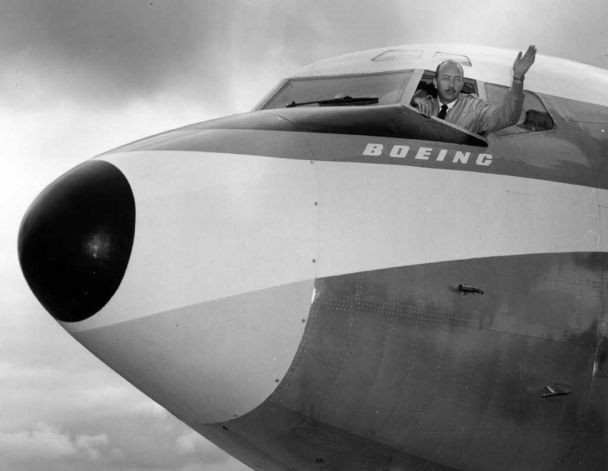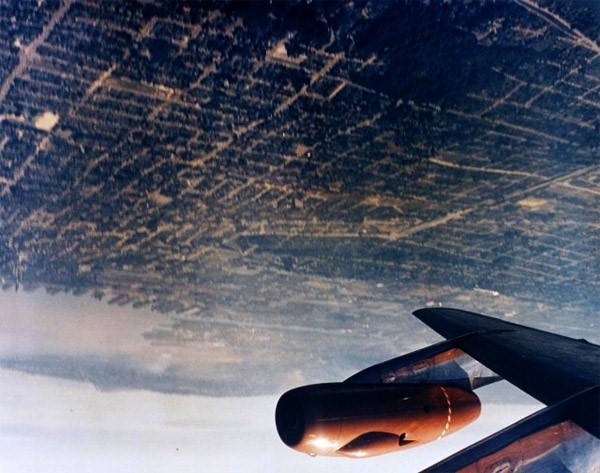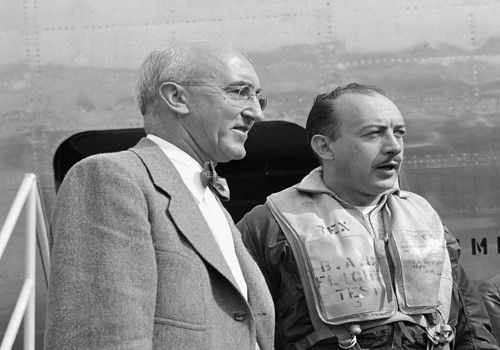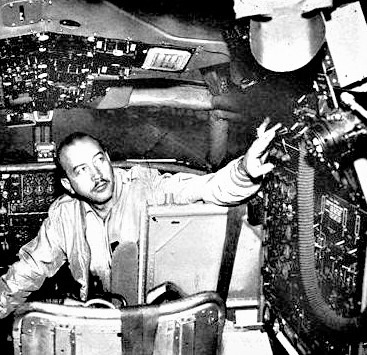Nuestro estimado lector y colaborador Sergio Barriga K. nos recomendó acceso a dos artículos de la revista Aviation Week que complementan muy bien la historia del noble B-707 que todos los pilotos que lo volaron por largos años en LAN recuerdan con cariño por sus extraordinarias características de vuelo, su fortaleza y su confiabilidad.
Boeing 707 Flight Testing – And Not Talking About Rolls
Jul 5, 2019 by Guy Norris in From The Archives

Boeing’s chief test pilot, Alvin “Tex” Johnston in a
707 cockpit
On Aug 7, 1955, Boeing’s chief test pilot, Alvin “Tex” Johnston famously rolled the company’s Dash 80 707 prototype over the astonished crowds gathered for the Gold Cup hydroplane race, the main event at Seattle’s Seafair.
Johnston calculated the 1g barrel roll maneuver, conducted twice, was perfectly safe and would prove to the world that the 707 was not only as strong as an ox but as agile as a fighter.

But while nobody could fault Johnston’s test piloting skills, his aerobatic display was certainly not appreciated by Bill Allen, Boeing’s president. Watching from the company’s yacht on Washington Lake, Allen had no warning of Johnston’s intentions and was as shocked as everyone else. After Johnston’s second roll, Allen turned to one of his guests, Larry Bell of Bell Aircraft who had a heart condition, and said “give me one of those damned (heart) pills. I need it worse than you do.”

Alvin “Tex” Johnston
In a 1990 Seattle Times story about Johnston, Carl Cleveland – Boeing’s head of public relations in the 1950s recalled that Bill Allen wanted the story suppressed, despite the fact that hundreds of thousands had just witnessed the aerial event. Cleveland remembered Allen turning to him on the yacht and saying “I don’t think we should have anything in the papers about that.” Naturally, Cleveland explained there wasn’t much Boeing could do to stop it but, to his immense relief and amazement, none of the papers carried the story the next day. It seemed most of the press there that day were sports writers more interested in hydroplane racing than aircraft. In these days of social media and instant reporting such a scenario is unthinkable today.
The next day Johnston was called into Allen’s office to face the music. Despite his protests that he was “selling the airplane” Allen simply told him to never repeat the performance. Allen himself could barely bring himself to talk about the barrel roll for years. Speaking to a conference in Seattle in 1977 he said “it has taken nearly 22 years for me to reach the point where I can discuss the event with a modicum of humor.”
Johnston also never spoke about the roll in public for another 15 years. At the time of Aviation Week’s 1956 707 test pilot story by Russell Hawkes the subject was still very much taboo. There is no mention of the 707’s roll performance in the report, which ironically mentions Johnston’s view that “for the sake of passenger comfort it may be desirable to use half-rate turns in holding patterns and instrument let-downs.” The story does, however, go into great detail about the overall impressive handling capabilities of the 707. It also reveals some interesting test highlights including the fact that during early phases of high-speed evaluation air-flow separation at the rudder induced such violent buffet that the flight engineer’s panel was ripped from its mounts!
Boeing 707 Barrel Roll – Pilot Tex Johnston Performs Roll In Dash-80 Prototype Aircraft In 1955:
Test Pilot Report on Boeing Jet 707
June 25, 1956 by Russel Hawkes
Garden City, L.I.- In spite of its higher perormance and greater weight, the Boeing 707 jet transport is less work to fly than equipment currently in service, according to A.M. “Tex”” Johnston, chief of flight test for Boeing.

flight test chief A.M. “Tex” Johnston.
Johnson amplified earlier reports of the 707’s handling characteristics (AW Nov 21, 1955) in an address before a meeting of eastern members of the Air Line Pilots Association here.
The 707 is somewhat harder to land in a cross-wind than current aircraft, he said.This is characteristic of airplanes with the swept wing. The up-wind wing is more efficient than the one downwind because the air flow across it is chordwise while the flow across the downwind wing is spanwise. The difference in lift thus produced imparts a downwind rolling moment.
Johnston said the 707 is easier to handle in this respect than other swept wing types he has flown because its spoilers can destroy much of the lift of either wing and the pod pylons have some effect as fences limiting spanwise flow. The rolling moment is not great enough to endanger a wing tip or a pod. Its effect is to lengthen the landing roll out. With the downwind landing gear bearing most of the aitplanes weight , the upwind gear produces less braking action because of its reduced traction.
The landing gear tread of he 707 is somewhat narrower than that of current airline types because it is neccessary to retract the big four- wheeled bogies into the fuselaje. There is no engine nacelle on the wing offering storage space for them . This relative narrowness does not affect the cross-wind capability of the plane according to Johnston.
Brake System
The 707 has a brake anti-skid system to prevent a wheel or bogie bearing a lighter friction load than the rest of the wheels being stopped by brake pressure, thus wearing tires unevenly. This occurs – wihout the anti-skid system- when a cross-wind partially unloads the upwind bogie, when icy spots are encountered on the runway, when blacktop runway surfaces melt in spots on a hot day , etc. Given the weights at which the 707 will operate, no pilot could hope to sense wheel skid and make pedal corrections, Johnston said.
The thrust reversers to be installed on the 707 will be about as effective braking units as the reversible pitch propellers now in use, he reported. They have an efficiency of about 50%. Tests of a fixed versión of the reverser mounted on the number two engine have been limited to a taxi speed of 80 knots because at higher speeds the assymetrical reverse thrust scrubs the nosewheel sideways. Reverser control will be a separate lever on the control pedestal because Boeing wants to avoid a complicatd throttle linkage.
A prototype of Boeing’s noise suppresser mounted on a single outboard engine for tests has been found to reduce the noise level 12 decibels or 17% from the noise level of the unsilenced engine. Johnston showed a film of the empty 707 holding altitude in a fly-over at 290 knots with three engines out and only the silenced engine operating.
Regarding the performance of the 707 at altitude , Johnston said that an angle of bank of 45 degrees is necessary to make a standard rate turn (three degrees per second) at the expected cruise altitudes and an indicated air speed of 205 knots. He suggested that for the sake of passenger confort it may be desirable to use half-rate turns in holding patterns and instrument let-downs. He acknowledged that the resultant expansión of the holding pattern may cause traffic control problems.
Lateral Control System
The lateral control system of the 707 includes spoilers, inboard cruise ailerons and outboard low speed ailerons, The system gives the airplane a rate of roll of about 36 degrees per second at cruising speeds.
The control lincage to the outboard ailerons is broken when the flaps are up and they remain fixed in neutral with the inboard ailerons and spoilers providing all lateral control at high speeds. This configuration was chosen to avoid aileron reversal which occurs at high subsonic Mach numbers.The area and tavel of the inboard ailerons are small to limit the possibility of reversal but they provide adecquate control in the event of spoiler failure.
The swept wing confguration of the airplane increases lateral controllability because of small amount of slip or skid causes flow on the forward wing to be more nearly chordwise than that of the aft wing.The resulting lift differential tends to roll the airplane into balanced flight. Lateral and directional controls are both effective at stalling speed.
All controls are manual with aerodynamic boost except de spoilers, which are hydraulically powered. The spoiler can be extended differentially for lateral control or symmetrically as speed brakes. While in use as speed brakes they can be used for lateral control by different ial retraction. Spoiler extension does not produce a strong pitching moment .
Pilot Technique
The landing attitude of the 707 is nose high. Recommended technique is to push the nosewheel on immediately after touch-down and extend the spoilers. These actions spill de lift off the wing and place 80% of the airplane’s weight on the wheels for effective braking immediately.
Johnston said that while the 707 changes trim radically as speed changes , there is little effect on trim from power changes. This means that full power can be applied quickly for a go-a round without obliging the pilot to fight heavy control forces. Trim change caused by air flow separation at high subsonic Mach numbers is also relatively slight. A small negative pitching moment is experienced rather than usual pitchup.
Johnston said that in early test phases a considerable buffet was caused by separation at the rudder. On one occasion the buffeting was violent enough to rip the flight engineer’s panel from its mounts. A fix has since been made, he reported.
Fin area of the 707 has been limited to prevent too sudden recovery from turbulence induced yaws. The propeller – driven Stratocruiser recovered with a snap and shudder that was sometimes unsettling to passengers.
There is no washout in the wing to the 707. Camber varies from station to station along the span of the wing and this is believed adequate to prevent tip stalls in normal operation.
Johnston said that climb-out in the 707 is made at 300 knots until increasing altitude brings the Mach number indication for that speed down to Mach .8 (about 30.000 feet). The remainder of the climb is made at Mach .8. At maximum gross weight the 707 reaches 35.000 feet in 30 minutes.
The 707 is capable of extremely rapid let-downs in the event of a pressurization failure. The procedure is to reduce power, extend the spoiler to deccelerate to 270 knots and extend the gear. With the wheels down, the pilot may accelerate to the landing gear placard speed of 310 knots and let down at 14.000 feet per minute with cabin angle no greater than 30 degrees. Constant flow oxygen masks for the passengers drop out of the ceiling if pressure fails. Oxygen quantity is adequate to supply a full load of passengers for a period equal to roughly half the time range of the airplane at 20000 feet. Range is penalized by cruising at any lower altiutude
0 Comments